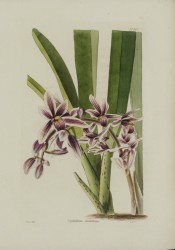Cymbidium simulans Rolfe
Cymbidium orchid with pendulous, many flowered racemes of yellowish flowers with a central purplish stripe. Often confused with Cymbidium aloifolium (L.) Sw. [RHSD].
Horticultural & Botanical History
‘We received this plant [Cymbidium aloifolium] about the year 1790 from China, where several varieties of it are cultivated. It grows also in India on trees, especially, according to Rheed. Hort. Malab. v.12. 17 t.8., on those of the Nux vomica. With us it requires the stove, and flowers sparingly. It should be potted in vegetable earth, covered with growing moss, and ought to have a geat deal of water. It increases itself without difficulty by separation.’ [LBC no.967/1824]. Probably the plant introduced to Britain in 1789 as C. aloifolium. [JD]. BM t.387/1797 as Epidendrum aloides.
History at Camden Park
Listed in the 1850 and 1857 catalogues [O.8/1850]. Cymbidium aloifolium was part of a consignment of plants sent from Kew by John Bidwill in November 1843 [AJCP]. This is the probable source.
Notes
Less likely is Cymbidium aloifolium (L.) Sw., southern India, distinguished from Cymbidium sumulans by erect flower spikes and a longer, more acute mid-lobe of the lip. [RHSD]. It occurs in many forms.
Published Jan 24, 2010 - 03:28 PM | Last updated Jan 24, 2010 - 03:36 PM
| Family | Orchidaceae |
|---|---|
| Category | |
| Region of origin | Himalayas to the East Indies |
| Synonyms |
|
| Common Name | |
| Name in the Camden Park Record |
Cymbidium aloifolium |
| Confidence level | medium |


